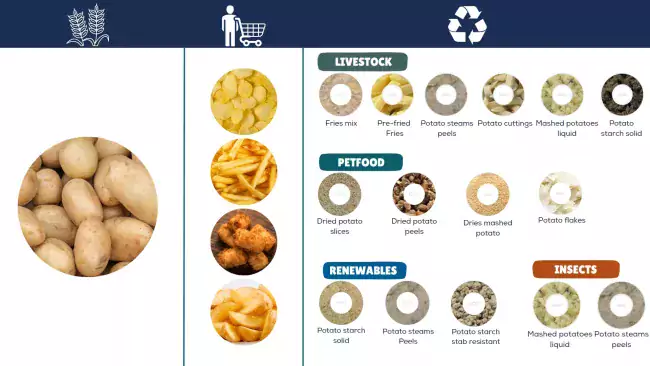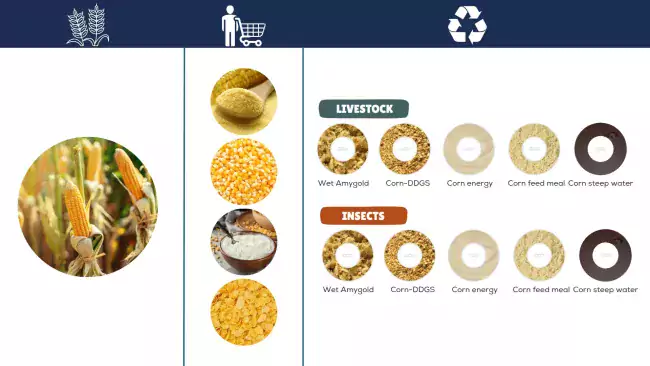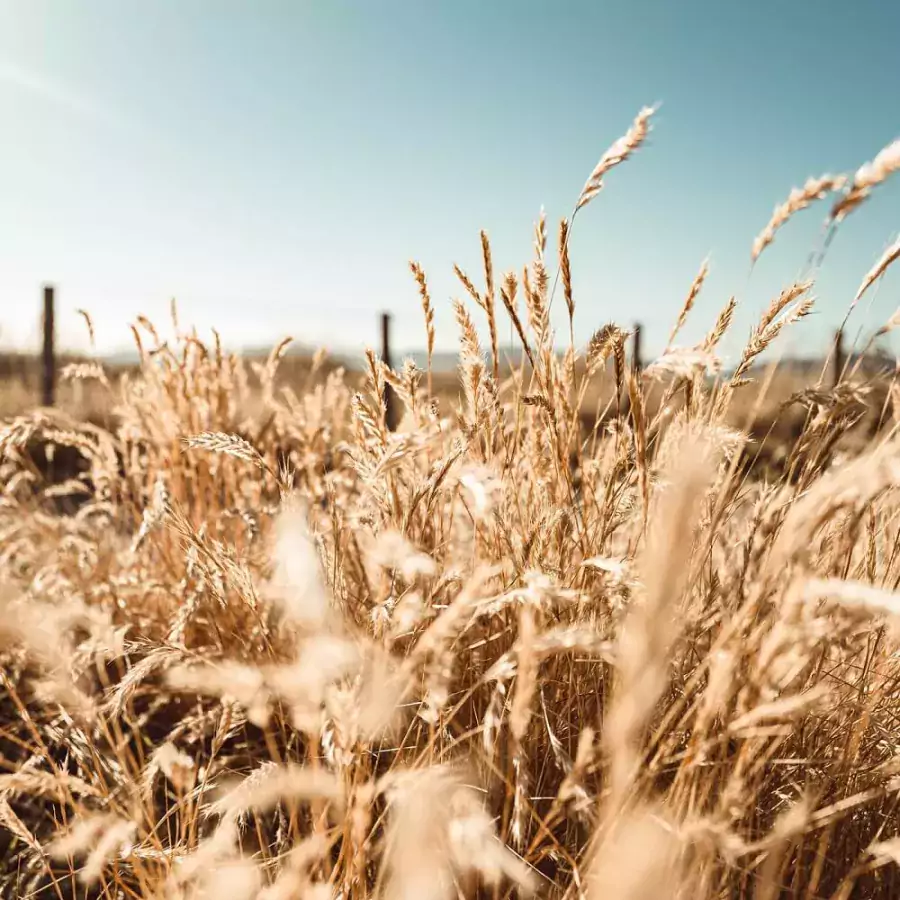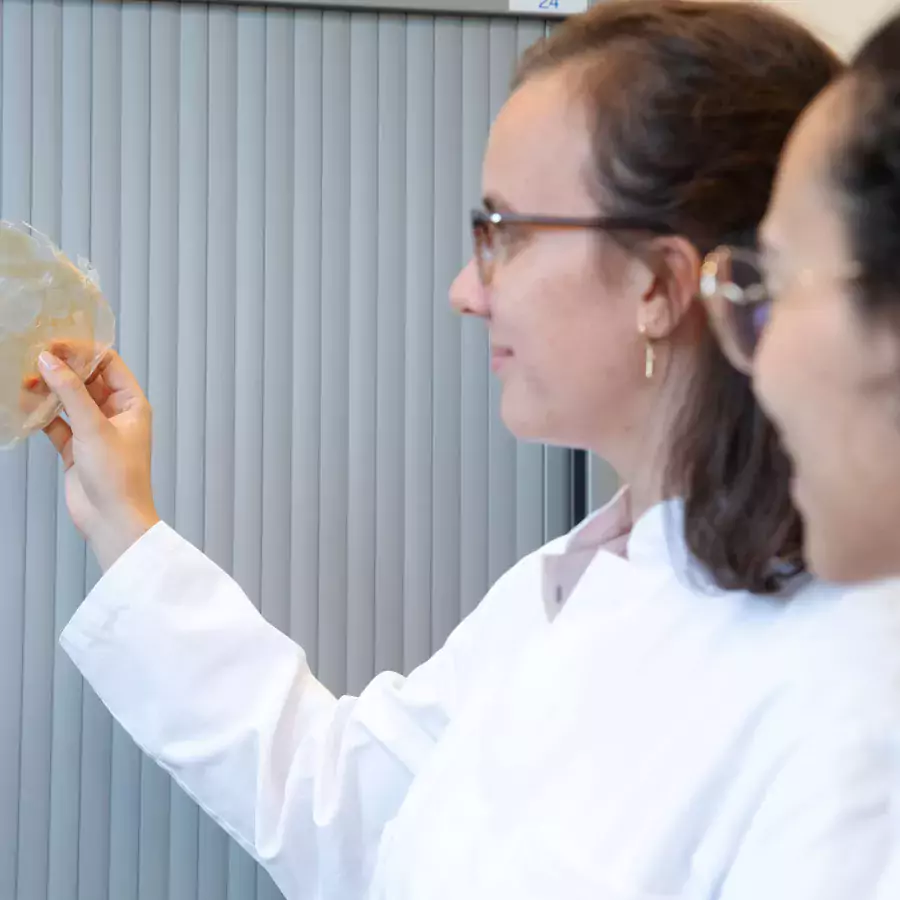Co-products are 'extra' products that can be created (unintentionally) during the production process of a main product.
For example, woodworking creates sawdust, which won’t be part of your new table or chair, as a co-product. We also see many co-products in the food chain. The production of orange juice creates citrus peels, beer brewing creates grain residues and fresh chips equal leftover pieces of potato.
These co-products were previously usually discarded. A shame as these organic co-products can be reused in various application areas such as animal feed, insect substrate, pet food, soil improver and as a renewable energy source.
At Looop, we create various types of (liquid) organic co-products, but what are these co-products used for?
From potato to co-product
An average of 7 million tonnes of potatoes are grown in the Netherlands every year. About half of these potatoes are sold to the potato processing industry. They are then made into potato wedges, crisps, chips, and other things. During the production process of these potatoes, such as the peeling and cutting, various co-products are released. These co-products are incredibly valuable and can be processed in multiple ways.
At Looop, we think it is important that co-products are used in the best possible way, thus minimising our carbon footprint. We use the Ladder of Looop to add value to co-products. Some potato co-products can already be found in products for human consumption today. Potato starch, for example, is used as a thickener. Not all potato co-products are suitable for human consumption. But that does not make those co-products useless, as other application areas can often be found for them. Potato steam peels, potato starch and potato fibre, for example, are very suitable for livestock feed. These co-products contain important nutrients such as starch, making them very valuable for animal feed and as substrate for insects.
Other potato co-products are also turned into pet food. They can be very useful as a (gluten-free) ingredient. Often, potato co-products are dried before they can be used in pet foods such as dog treats.
When potato co-products are no longer suitable for human or animal food, they can be used to produce renewable energy sources. They are then processed in a digester, in which the organic material is broken down and converted into biogas or biomass for energy generation. This way, potato co-products can contribute to the production of renewable energy and reduce the dependence on fossil fuels.

From beer to co-product
Beer consists of four main ingredients: water, hops, malt and yeast. The brewing process follows several steps that involve grains such as barley, wheat, rye or corn. These grains are malted and then processed into malt extracts to make beer. Brewing beer releases various co-products such as brewers' grains, brewer's yeast and feed beer. Brewers' grains are a co-product created during the beer brewing process. It is the solid residue that remains after filtering the malt. This co-product still contains many nutrients and fibre. As a result, it can be used to make bread, as animal feed or as a food source for insects. Another beer brewing co-product is brewer's yeast. Brewer's yeast is created after the fermentation process. The leftover yeast can be reused for new brews, but it can also be used for other purposes. In shops, for example, you can find brewer's yeast as a dietary supplement because of its high amount of B vitamins and chromium. Brewer's yeast is also found in liquid and dried form in pig feed. Feed beer is also created during the brewing process. This is beer that has gone through the full brewing process but does not meet quality standards or is not suitable for human consumption. Feed beer is often released when a new production line is started while the 'old' beer is still in the brewery's pipes. Instead of wasting it, feed beer is used as animal feed, effectively harnessing its nutritional value.
Lastly, beer brewing also releases the co-product beer waste. Beer waste is a stream that is released during the beer brewing process that is no longer fit for human or animal consumption. The co-product is processed in a digester to make biogas or biomass for the generation of renewable energy.
Lastly, beer brewing also releases the co-product beer waste. Beer waste is a stream that is released during the beer brewing process that is no longer fit for human or animal consumption. The co-product is processed in a digester to make biogas or biomass for the generation of renewable energy.

From maize to co-product
Besides being a grain, maize is also eaten as a vegetable. In shops, you will find maize in various forms, such as corn on the cob, canned or jarred corn kernels, cornflakes, cornstarch and as popcorn. Maize is a versatile crop and its co-products are utilised in many ways. Various maize co-products are upgraded to animal feed, food sources for breeding insects and as a source of renewable energy.
Processing maize also creates products that cannot be found in shops. One of these co-products, for example, is released during the extraction and refining of glucose from maize; Corn Energy. This is an energy-rich food source used as animal feed. Corn Energy is rich in carbohydrates and fats, and contributes to a balanced diet for livestock. Corn Steep Water and Corn feed meal also often find a new purpose. Maize soaking water is created during the soaking and fermentation of maize. Maize feed meal is obtained after grinding and processing maize. Maize feed meal has a high fibre content and is a valuable ingredient in cattle feed. It contributes to healthy digestion and nutrition for pigs and cows.
In addition, co-products of maize are also a good food source for breeding insects. Insects are a source of protein and are very suitable as a protein and fat source for animal feed, pet food and even human consumption.
Co-products that are no longer suitable for human consumption, animal feed, pet food or insect feed can be used in a digester to produce biogas. This will replace scarce fossil fuels with renewable energy.

We contribute to sustainability and the efficient use of natural resources by using and processing all our co-products responsibly. At Looop, we strive for a 100% circular world. By ensuring the responsible processing and reusing of co-products, we reduce waste, emissions and close the loop.
Together we are #MovingCircularityForward








